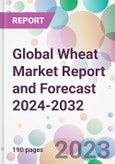According to the report, the global wheat market is projected to grow at a CAGR of 5.3% between 2024 and 2032 reaching a value of approximate USD 248.97 billion by 2032. Aided by the increasing demand for staple food products and the growing applications of wheat in various industries, the market is expected to grow significantly by 2032.
Wheat is a crucial cereal grain that is extensively grown worldwide. It is a primary food source, providing about 20% of the calories consumed globally. Wheat is a versatile crop, primarily used for the production of flour, which forms the basis for a large variety of food products such as bread, pasta, pastries, and noodles. Beyond its extensive culinary applications, wheat also holds substantial importance as a raw material in industries like animal feed, biofuel production, and brewing.
The escalating global population and increased consumer preference for convenience food products are significant drivers of the global wheat market growth. With the growing awareness of the health benefits associated with whole-grain consumption, there has been a notable shift towards whole wheat products, which are rich in dietary fibre, vitamins, and minerals. This is leading to a surge in demand for various wheat-based products.
The booming bakery sector, characterised by an expanding portfolio of bakery products and the rising trend of artisanal and premium baked goods, has further contributed to the increasing popularity of wheat, as it is the primary ingredient in a wide array of these products.
Moreover, the diversifying uses of wheat in various industries play a significant role in influencing the wheat market outlook. In the animal feed sector, wheat is used as a nutritious ingredient in livestock feed formulations. The biofuel sector, on the other hand, utilises wheat for the production of ethanol through fermentation processes.
Furthermore, with increased health consciousness among consumers and awareness regarding the nutritional benefits of whole grains, wheat market demand is witnessing a surge. These include whole wheat bread, pasta, and cereals which are perceived as healthier alternatives to their refined counterparts.
Wheat is a crucial cereal grain that is extensively grown worldwide. It is a primary food source, providing about 20% of the calories consumed globally. Wheat is a versatile crop, primarily used for the production of flour, which forms the basis for a large variety of food products such as bread, pasta, pastries, and noodles. Beyond its extensive culinary applications, wheat also holds substantial importance as a raw material in industries like animal feed, biofuel production, and brewing.
The escalating global population and increased consumer preference for convenience food products are significant drivers of the global wheat market growth. With the growing awareness of the health benefits associated with whole-grain consumption, there has been a notable shift towards whole wheat products, which are rich in dietary fibre, vitamins, and minerals. This is leading to a surge in demand for various wheat-based products.
The booming bakery sector, characterised by an expanding portfolio of bakery products and the rising trend of artisanal and premium baked goods, has further contributed to the increasing popularity of wheat, as it is the primary ingredient in a wide array of these products.
Moreover, the diversifying uses of wheat in various industries play a significant role in influencing the wheat market outlook. In the animal feed sector, wheat is used as a nutritious ingredient in livestock feed formulations. The biofuel sector, on the other hand, utilises wheat for the production of ethanol through fermentation processes.
Furthermore, with increased health consciousness among consumers and awareness regarding the nutritional benefits of whole grains, wheat market demand is witnessing a surge. These include whole wheat bread, pasta, and cereals which are perceived as healthier alternatives to their refined counterparts.
Market Segmentation
The market can be divided based on type, application, and region.Market Breakup by Type
- Whole/Raw
- Flour
- Others
Market Breakup by Application
- Feed
- Food
- Biofuel
- Others
Market Breakup by Region
- North America
- Europe
- Asia Pacific
- Latin America
- Middle East and Africa
Competitive Landscape
The report looks into the market shares, plant turnarounds, capacities, investments, and mergers and acquisitions, among other major developments, of the leading companies operating in the global wheat market. Some of the major players explored in the report are as follows:- Nisshin Flour Milling Inc.
- Siemer Milling Company
- Miller Milling Company
- Grain Craft
- General Mills
- ITC Limited
- Ardent Mills
- Farm Fresh Wheat
- Sunnyland Mills
- Bay State Milling Company
- Others
Table of Contents
1 Preface2 Report Coverage - Key Segmentation and Scope4 Key Assumptions7 Opportunities and Challenges in the Market15 Value Chain Analysis19 Key Trends and Developments in the Market
3 Report Description
5 Executive Summary
6 Market Snapshot
8 Global Wheat Market Analysis
9 North America Wheat Market Analysis
10 Europe Wheat Market Analysis
11 Asia Pacific Wheat Market Analysis
12 Latin America Wheat Market Analysis
13 Middle East and Africa Wheat Market Analysis
14 Market Dynamics
16 Trade Data Analysis (HS Code - 1001)
17 Price Analysis
18 Competitive Landscape
List of Key Figures and Tables
Methodology

LOADING...
Table Information
| Report Attribute | Details |
|---|---|
| No. of Pages | 190 |
| Published | November 2023 |
| Forecast Period | 2024 - 2032 |
| Estimated Market Value ( USD | $ 164.71 Billion |
| Forecasted Market Value ( USD | $ 248.97 Billion |
| Compound Annual Growth Rate | 5.3% |
| Regions Covered | Global |









